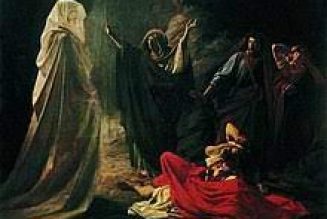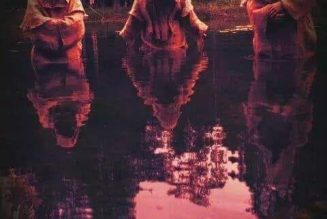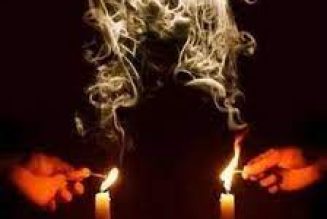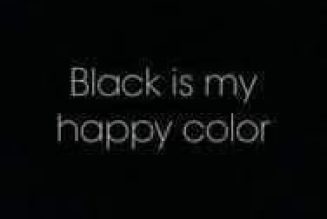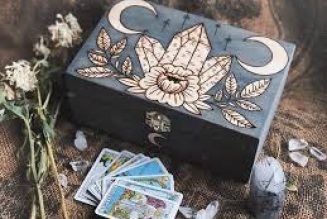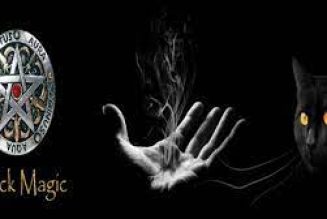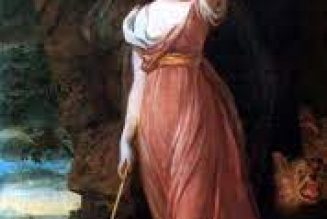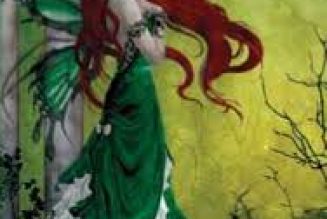The area of the Cotswold Hills has long been famous as a centre of witchcraft lore.
In modern days two events have brought this fact to notice:
the so-called ‘Witchcraft Murder’ on Meon Hill in nineteen forty five, and the opening of Mr Cecil H Williamson’s witchcraft museum at Bourton-on-the-Water at Easter nineteen fifty six, which aroused considerable controversy in the area at the time.
The museum closed about ten years later, Mr Williamson having opened another at Boscastle in Cornwall.
During the years it remained at Bourton-on-the-Water, this witchcraft museum, arranged in a picturesque fifteenth-century Cotswold stone house provided a fascinating panorama of objects connected with magic and witchcraft.
It contained, among innumerable other exhibits, an indoor shrine used by a witch for thanksgiving to the Old Gods in recognition of spells successfully
accomplished, and a life-size representation of a scene in an old-time witch’s cottage, showing how a ‘divining familiar’ worked.
A wax figure of a witch sat before a big old-fashioned table, on which was a skull draped with a black shawl; also on the table were a black hilted knife, and four candles in crude, home-made candlesticks of bone.
Specimens of different herbs were displayed before the familiar, a small animal.
It was explained that the animal became possessed by a god or a spirit and indicated the right herb to use in a particular case.
This was in fact a correct representation of a ‘divining familiar’.
It has been known for a cat to be used in the same way, to divine by selecting cards from an outspread pack with its paw.
The exhibit which aroused most controversy, however, was a lifesize wax figure of an almost nude witch-priestess lying upon an altar.
She was described as a priestess ofTanat, the Phoenician moon goddess, whose worship, it was claimed, was still carried out in Cornwall and
the West of England, being celebrated by ritual bonfires on the old pagan festival dates.
In June nineteen fifty-six someone hanged a cat from a beam outside the museum.
Mr. Williamson interpreted it as a ‘death warning’, from one who objected to the museum’s being opened.
Mr. Williamson’s museum would have been controversial anywhere.
It was doubly so in the Cotswolds, where fear of witchcraft as a sinister influence is still lively today.
The events of the Meon Hill murder have not been forgotten; nor how the famous anthropologist, the late Dr Margaret Murray, spent a week in the area of the murder, ostensibly as an artist with a sketchbook, but actually carrying out her own investigation.
Later, she stated publicly that she believed the murder victim, an old man named Charles Walton of the village of Lower Quinton, had been killed because of the local belief in witchcraft.
Walton was found dead under a tree on Meon Hill, on 14th February, nineteen forty five.
His body was pinned to the ground by a hayfork, and his throat and chest had been slashed in the form of a cross.
Police investigating the murder came up against a wall of silence, and no arrest was ever made.
February 14th is Candlemas by the Old Calendar, which is twelve days behind the present dating; and Candlemas is one of the Great Sabbats of the witches.
Recently another investigation into this mysterious killing has been carried out by Donald McCormick, who published his findings in his book Murder by Witchcraft (John Lorig, London, nineteen sixty eight).
Mr McCormick has uncovered new facts about the man who was killed, which have convinced me personally that witchcraft, or rather the fear of witchcraft, was the motive for this murder; Charles Walton was slain because someone feared his powers as a witch.
He was slain bloodily because to spill a witch’s blood destroyed their influence.
In eighteen fifty six an old woman named Anne Turner had been killed in a similar manner, in another Cotswold village, Long Compton, by a
man who believed her to be a witch.
He was influenced by an old local saying :
“There are enough witches in Long Compton to draw a waggon load of hay up Long Compton Hill.”
The traditional meeting place of the Cotswold witches is the Rollright Stones, a prehistoric stone circle between Long Compton and Chipping
Norton.
Outside the circle and across a road is a big standing stone called the King Stone, strangely weathered by the passing centuries; and nearby in a field is a cromlech of big stones called the Whispering Knights.
On the twelfth of May nineteen forty-nine, a witches’ Sabbat was held at the Rollright Stones which was observed by two independent witnesses, whose
stories got into the local and national press.
It was the night of the full moon, and May Eve by the Old Calendar.
The latter, as stated above, is twelve days behind the New, or Gregorian Calendar, which was adopted in Britain in seventeen fifty-two; but traces of the old reckoning can still be found in custom and folklore.
The man who witnessed the rites had gone there because he had heard rumours of witch meetings there before, and curiosity attracted him.
He was unable to get very close, but he saw a number of people, both men and women, performing a ritual around the Kings Stone, with chanting and dancing.
The leader wore a disguise, which the observer thought was a goat-headed mask.
The other eye-witness, a woman, was afraid to remain, and fled from the scene.
Since this time, traces of bonfires have been found at the Rollright Stones on various occasions; but since the newspaper publicity, witches have tended to avoid using the Stones for their meetings.
However, the magazine Life International, in its issue dated the eighteenth of May nineteen sixty-four, carried a detailed article about witchcraft in Britain, which included photographs of a special meeting at the Rollright Stones organized by a London coven under the leadership of Mrs. Ray Bone, whose witch-name is
Artemis.
She invoked the Old Gods of the witches, and the coven joined hands to dance round a bonfire lit within the circle of stones.
Then the witches jumped over the flames of the fire, which according to their ritual symbolized the life-giving properties of the sun.
The rite was held to celebrate May Eve, the traditional beginning of summer.
A remarkable historical novel, based upon fact, and dealing with witchcraft in the Cotswolds in the seventeenth century, is The Silver Bowl, by Hugh Ross Williamson, first published in nineteen forty-eight.
It deals particularly with Chipping Campden, and the strange events are known as the Campden Wonder, when three witches, Joan Perry and her two sons were hanged for the supposed murder of a man who had disappeared, but who later returned alive to the village.
It mentions Seven Wells, within a circle of trees on a hill south of Chipping Campden, as the meeting place of the seventeenth-century coven, and contains many unusual details about witchcraft, which it calls “the Craft of the Wise”.
At the old Fleece Inn at Bretforton, near Evesham, on the edge of the Cotswolds, the custom is kept up of drawing three white circles on the hearth, “to stop witches from coming down the chimney”.
This derives from the old idea that the influence of witchcraft could enter a house through the windows, the doors, or the chimney; and protective amulets
were hung or placed in these locations to prevent it.
The number three has always been sacred and magical, while the circle was anciently regarded as the symbol of perfection and eternity, and whiteness as the
colour of purity. Hence the protective magic of this traditional rite.
